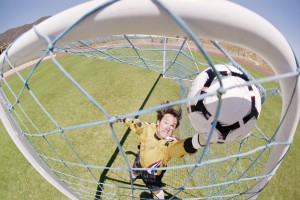
Safety Tips
The WCSSF in accordance with Indiana Soccer, the following safety guidelines must be followed at every game:
- Shin-guards must be worn under the socks and completely covered by the socks.
- Cleats that are worn must not have a toe cleat.
- No jewelry can be worn during the game. This includes, but not limited to bracelets, watches, necklaces, earrings or rings.
- A player must not use equipment or wear anything which is dangerous to himself or another player. For example, metal barrettes or bobby pins are not allowed.
- Any player who wears eye glasses MUST wear a safety strap. This includes sunglasses as well.
In addition to these steps, some are recommended head gear as well as mouth pieces for both goalies and players. Although the studies vary, some would argue that the mouth piece helps prevent concussions, or, in the least, helps absorb some of the force both the head and brain receive during contact.
The WCSSF is reluctant at this time to insist that all the players wear head gear and mouth pieces. Instead we leave this decision up to the parents, although we highly recommend it especially for goal keepers and agressive players.
WCSSF Concussion Guidelines
1. The Coaches, Assistants, Team Managers, and Referees should work together to recognize and evaluate possible concussions.
a. Remove athlete from play. Look for signs and symptoms of a concussion if the player has expe¬rienced a bump or blow to the head. Athletes who experience signs or symptoms of concussion should not be allowed to return to play. When in doubt, keep the athlete out of play.
i. Referees: If, during a contest, an official observes a player and suspects that the player has suffered a head concussion or head injury by exhibiting concussive signs (including appearing dazed, stunned, confused, disoriented, to have memory loss, or the athlete is either unconscious or apparently unconscious), the official should notify a coach that a player is apparently injured and advise that the player should be examined by an appropriate health care Professional.
ii. If a concussion event occurred during a match, and regardless of whether the student athlete returns to play or not, following the contest, the incident should be included in the reports submitted by the referee as well as the coach.
b. Ensure athlete is evaluated by a health care professional. Do not try to judge the seriousness of the injury yourself. Record the following to help health care professionals in assessing the athlete:
i. cause of the injury and force of the hit or blow to the head
ii. any loss of consciousness (passed out/ knocked out) and if so, for how long
iii. Any memory loss immediately following the injury
iv. any seizures immediately following the injury
c. Inform athlete’s parents or guardians about the known or possible concussion and provide them with the information above. Make sure they know that a health care professional experienced in evaluating concussions should see the athlete.
d. Allow athlete to return to play ONLY with permission from an appropriate health care professional with experience in evaluating concussions.
2. You can’t see a concussion, and some athletes may not experience and/or report symptoms until hours or days after the injury. If you have any suspicion that your athlete has a concussion, you should keep him/her out of practice/games and seek medical care.
3. Sometimes players and parents wrongly believe that it shows strength and courage to play injured. Discourage others from pressuring injured athletes to play. Don’t let athletes persuade you that they’re “just fine” after they have sustained any bump or blow to the head.
4. Any player with a confirmed concussion or head injury should be medically cleared by an appropriate health care Provider prior to resuming participation in any practice or competition.
5. For additional information about concussions, please go to http://www.soccerindiana.org/UserFiles/file/Vince%20Education/Care%20and%20Prevention/ParentsFactsheet.pdf
OTHER RESOURCES:
Care and Prevention PPT for YTC and E
Game Plan for Optimal Nutrition
Four Common Myths About Nutrition
